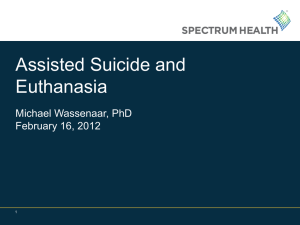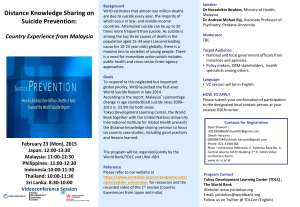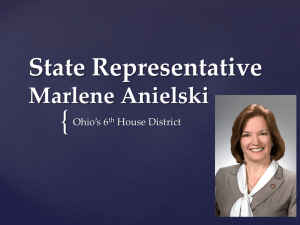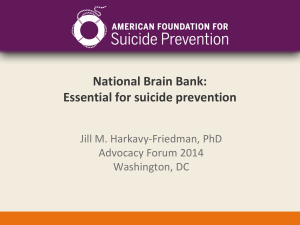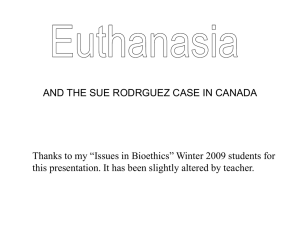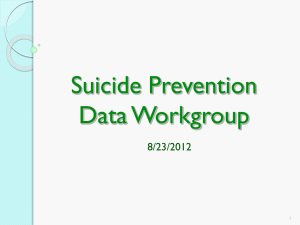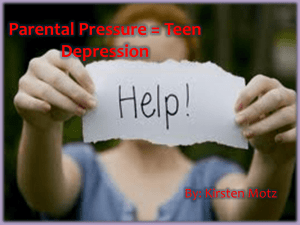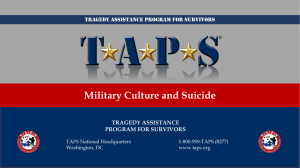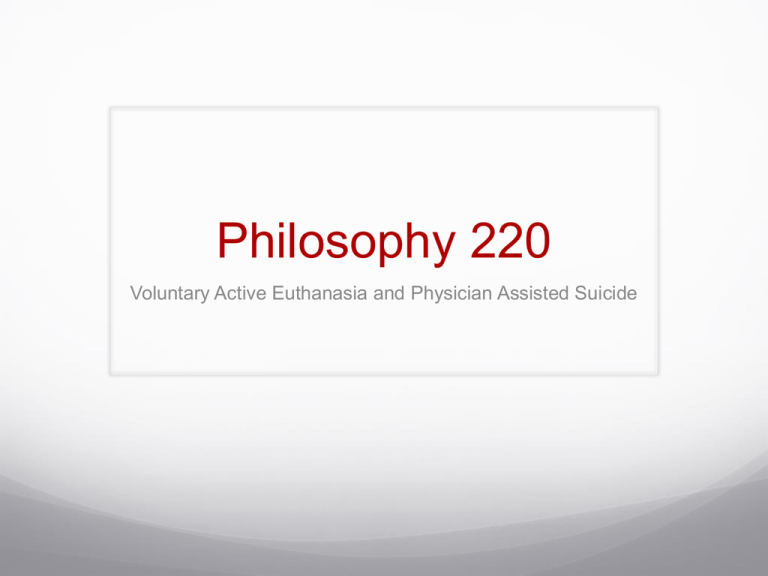
Philosophy 220
Voluntary Active Euthanasia and Physician Assisted Suicide
Suicide: Some Definitions
Suicide is the intentional and voluntary ending of one’s own life.
Though there are significant questions about the moral status of
suicide, our focus in this section addresses a narrower concern:
assisted suicide.
Assisted Suicide refers to situations where individuals assist
another person in committing suicide, usually because something
about the person’s situation prevents them from completing that
act on their own.
We are specifically interested in the concerns raised by the
possibility of physicians assisting individuals in this way.
Though some people equate physician-assisted suicide with
voluntary active euthanasia, there are others who insists that they
are importantly different.
Brock, “Voluntary Active
Euthanasia”
The aim of Brock’s essay is to defend the moral
permissibility of VAE, in those instances where the patient
exhibits the requisite competence.
His defense rests on two fundamental moral values:
1. Individual self-determination (autonomy)
2. Individual well-being
The basic argument is that these principles jointly support
the claim that patients should have the right to make
decisions about their medical care and inasmuch as VAE is
consistent with these values, VAE is a morally permissible
choice for patients to make and doctors should respect this
choice.
Two Moral Values
When we consider the two values at the heart of Brock’s argument,
we can appreciate their centrality not only to our thinking about patient
rights, but to many basic moral intuitions.
The first value speaks to our status as moral agents. Assuming
competency, we generally agree that people have a right to define
their own conception of a good life, at least to the degree that it
affects them.
This is what Brock is calling self-determination.
The second value addresses our relationship to other self-determining
agents. The basic idea is that to the extent that we are involved with
others, we should be guided by a concern for their personal wellbeing.
To paternalistically interfere with their self-determination, we need very
good reasons to think that we are making them better off than they would
be if they chose for themselves.
What about Physicians?
One serious objection raised against VAE addresses the moral
concerns and obligations of the physicians potentially involved in
the process.
Clearly, if a particular physician is morally opposed, they should
not be forced to participate.
More significantly, it has been argued that VAE is directly opposed
to the principled core of the code of ethics under which doctors
operate, undermining the trust and confidence patients have in
doctors.
Brock responds by noting that just the opposite may very well be
the case. In a system which supports VAE, patient autonomy and
well-being would be recognized as paramount values, and patients
would rightly believe that their interests we of fundamental
importance to their doctors.
Doerflinger, “Assisted Suicide:
Pro-Choice or Anti-Life?”
Richard Doerflinger is Associate Director for Pro-Life
Activities for the United States Conference of Catholic
Bishops.
He references the religious context of his position at the
beginning of his essay, but his argument is moral rather than
religious.
Doerflinger objects to the permissibility of assisted suicide
(including active euthanasia) on two bases:
1. The standard pro-choice appeal to autonomy is at odds with itself.
2. Pro-choice advocates fail to appreciate the risks of a slippery slope
towards allowing wrongful practices of killing.
Pro-Choice?
Though more familiar to us from the debate about the
moral and legal status of abortion, the label ‘pro-choice’
has been employed by advocates and critics of
assisted-suicide to reflect the focus on selfdetermination highlighted by people like Brock.
At first pass, Doerflinger notes that such a focus seems
incompatible with the idea that human life has intrinsic
value.
Instead, it seems that life has only a subjective value:
valuable only if the subject of the life values it.
Reprising the Argument from SelfDetermination
Doerflinger summarizes this position as the claim that
we should respect the wishes of patients contemplating
asking for assistance in ending their life because
humanity or personhood has a dignity that demands
respect for individual freedom.
• They claim that suicide is the “ultimate” exercise of
self-determination, and thus deserves not only respect,
but the assistance of others.
• This has led some, (most notably the members of the
Hemlock Society) to advocate a constitutional “right to
die.”
A Constitutional (but not moral)
Contradiction
According to Doerflinger, this argument departs from American
traditions on liberty.
The inalienable human rights described in the Declaration of
Independence are: “life, liberty, and the pursuit of happiness.”
These rights are importantly nested. Liberty allows for the pursuit
of happiness and life allows for liberty.
“Safeguards against the deliberate destruction of life are thus seen as
necessary to protect freedom and all other rights” (318c2).
If this is right, suicide is not a fundamental exercise of liberty, but
its contradiction.
“If life is more basic than freedom, society best serves freedom by
discouraging rather than assisting self-destruction” (ibid.).
A Moral Contradiction?
Though this argument is aimed at positions like that
articulated by the Hemlock Society, Doerflinger suggests it
has broader implications.
Advocates of assisted suicide tend to prioritize the
avoidance of suffering over and above freedom.
Freedom (and life itself) is viewed as instrumental to the value
of happiness (the avoidance of suffering).
On this system, someone who is suffering and yet chooses to
live could be seen as irrational.
But, Doerflinger insists, this prioritization is ultimately
incoherent. It puts one choice (the choice for death) over all
other choices that the choice makes impossible.
Back to the Slope
In addition to this conceptual argument, Doerflinger also highlights
some possible dangers flowing from the acknowledgement of the
permissibility of assisted suicide.
Amongst the concerns he highlights are:
possible changes in legal doctrines and definitions of “terminal
illness”
possible prejudice against citizens with disabilities
alterations in the character of the medical profession
the negative influence of the human “will to power”
While acknowledging the limitations of these slippery slope
arguments, he insists that cumulatively they give us reason to
pause in the face of legally (or morally) approving of assisted
suicide.
Watts & Howell, “Assisted Suicide is Not
Voluntary Active Euthanasia”
Watts and Howell think that the common assumption that
assisted suicide should be understood as a form of
euthanasia (VAE) is mistaken, and that once they are
distinguished, it becomes apparent that criticisms of VAE do
not hold against assisted suicide (at least in some forms).
They define VAE as the “administration of medications or other
interventions intended to cause death at a patient's request”
(324c1)
Assisted suicide, by contrast, is “provision of information,
means, or direct assistance by which a patient may take his or
her own life” (ibid.).
3 Levels of Assistance
Once we define assisted suicide in this way, it becomes
apparent that not all assistance is the same.
The most minimal form of assistance is providing
information to patients about means of suicide.
A more substantial form is providing the means of
suicide.
Finally, physicians could supervise or directly aid in the
suicide itself.
Some Possible Concerns
Watts and Howell recognize that assisted suicide can raise
some possible concerns but they ultimately argue that these
concerns are misplaced.
That assisted suicide will lead to abuse of vulnerable persons
That it will undermine trust between patients and physicians
That it will weaken societal resolve to increase resources
allocated to care of the dying
Far from leading to these possible consequences, they insist
that normalizing physician participation in end of life
decisions might actually lead to an overall decrease in
suicide rates.
Conclusion
Watts and Howell ultimately defend “limited” physicianassisted suicide.
More specifically, they support legislation and policies
which would allow for providing information and
providing the means of suicide.
They draw the line at supervising or directly aiding the
act, on the basis of the potential abuse of power or
influence of attending physicians.

